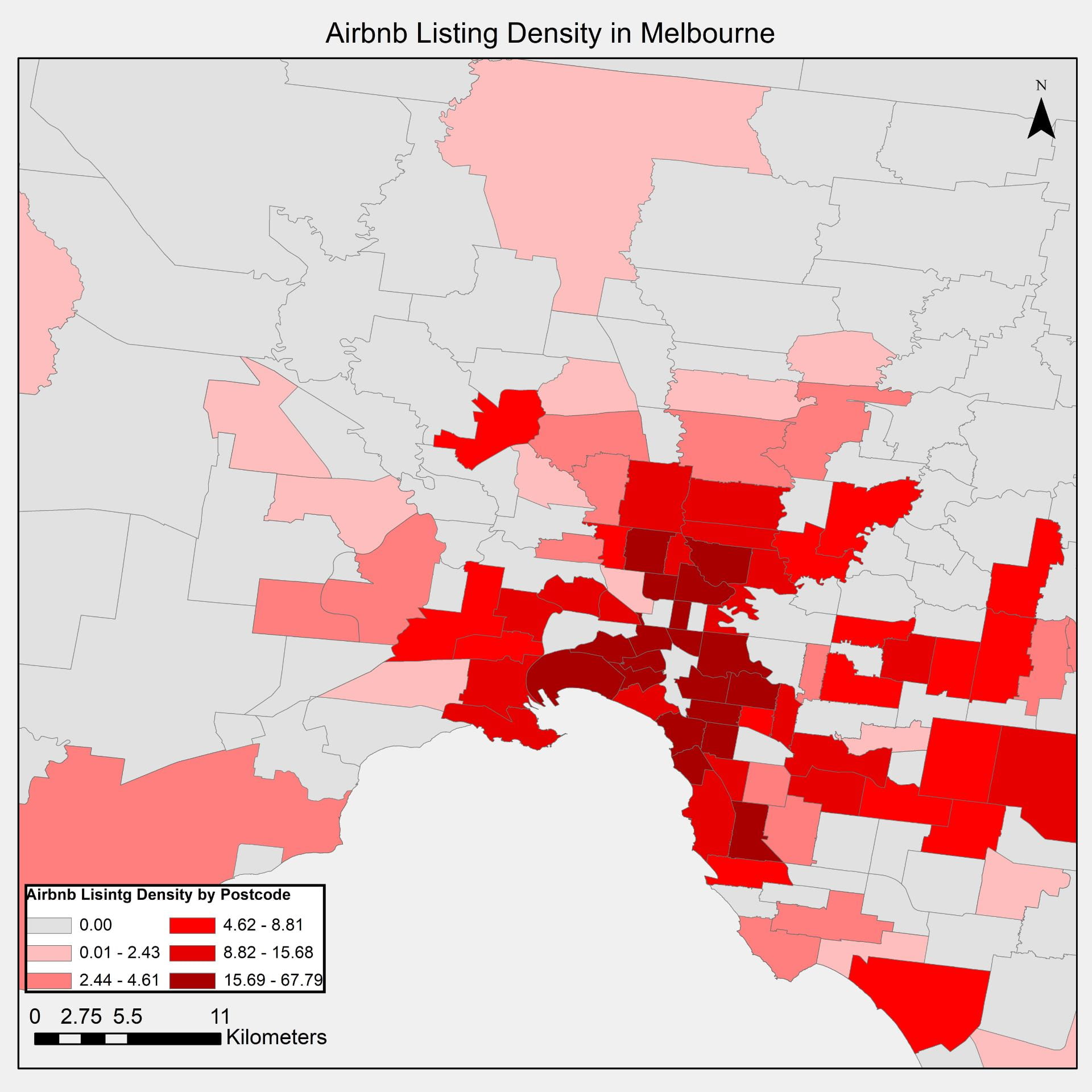
The Effects of Short-Term Tourist Rentals on Local Residents
Dr William Cheung, Senior Lecturer, Property, University of Auckland Business School; Assoc Professor Edward Yiu, Member of
the Faculty Research Committee, University of Auckland Business School.
This Press Release was contributed by (Cheung & Liu 2022) and posted by AUSTRALIA’S SPATIAL INTELLIGENCE NETWORK
(AURIN) on 4 Oct., 2022 and has granted the permission to use for this reporting.

Using APM (Australian Property Monitors) Point Level Data and the Inside Airbnb dataset available through AURIN, researchers at the University of Auckland have assessed the impact of short-term tourism rentals, in particular, those through Airbnb, on rental prices across different suburbs in Melbourne, Australia.
Cheung & Yiu’s (2022) study ‘Touristification, Airbnb and the tourism-led rent gap: Evidence from a revealed preference approach’, addresses critical questions related to these rentals and their impact on local residents. In particular, their work seeks to move away from assessments of these rentals as having only positive or negative effects, contributing to a more nuanced understanding of the costs and opportunities of this accommodation style in different types of neighbourhoods.
Problem
The rise of home-sharing platforms, such as Airbnb, has driven the process of ‘touristiflcation’ in major tourism cities. Touristiflcation is a term used to describe tourism-induced gentriflcation, with the process often leading to the transformation of a community into a tourism commodity. For example, services, facilities, and shops may be re-oriented towards the tourists’ preferences rather than local residents, impacting the social and economic value of housing in these areas.
These changes have the potential to be positive if the touristiflcation process increases a neighbourhood’s appeal and attracts improved amenities. However, if they contribute to a loss of relevant or useful local amenities, residents may seek to move elsewhere, leading to their displacement. While tourism is a leading industry in many
global cities, creating jobs and enhancing the flnancial well-being of destinations, the touristiflcation process led by home-sharing platforms has created rifts between local residents and visitors. This has left governments worldwide to decide how Airbnb-style accommodation should be regulated. For example, Christchurch City Council in New Zealand has recently introduced rules regulating Airbnb-style accommodation, requiring homeowners to obtain council approval in order to rent out their properties as un-hosted visitor accommodation in residential areas. The council can consider impacts on neighbours, including noise and trafflc movements, before deciding whether to grant or decline this approval, which also carries a cost of NZD $1000.
However, questions remain about whether such a ‘one-size-flts-all’ bed tax is the best way to govern the Airbnb market, as well as how we can best understand the impact of these rentals on local communities.
Approach
Most previous studies on the effects of Airbnb-induced touristiflcation have considered the phenomenon either entirely positive or entirely negative. However, this approach does not fully capture the impacts of tourism in transforming urban neighbourhoods and has left unanswered questions regarding the optimal design of relevant policies.
Cheung & Yiu’s (2022) study seeks to provide a new perspective on Airbnb’s impacts on urban housing markets in relation to residential location preferences – that is, the neighbourhood qualities where people want to live.
Their analysis uses a tourism-led rent gap model – identifying how and where short-term rentals impact rents in their geographic area, compared to expected rents if these short-term rentals were not present – to argue that the touristiflcation process in a neighbourhood can result in both positive and negative external effects, as revealed by different magnitudes and directions of rent gaps. In the study, they compare similar properties across different areas of Melbourne, with residential rental rates used to identify the revealed preference of locals about their residential location choices, after considering all factors involved. Using more than 22,000 Airbnb and 200,000 residential rental listings in Melbourne (Figure 1), their findings provide new evidence on how touristiflcation contributes to a tourism-led rent gap in high-density neighbourhoods and a negative rent gap in low-density neighbourhoods.
With these flndings, they note that high-density neighbourhoods, such as those with a large number of apartments, may experience net positives as a result of touristiflcation, while lower-density neighbourhoods may experience more negative effects.

Figure 1. Airbnb listing density in Melbourne by postcode (Source: Cheung &Yiu)
“With such a granular level of rental data provided by aurin, we can better understand the dynamics between airbnb and residential rental markets. The beauty of having such granular rental property data is that it allows us to have a much more in-depth analysis of the factors that contribute to causing changes in neighbourhoods, pinpointing the source of rental differentials and offering more insights on the effects of Airbnb-induced touristiflcation,” Dr Cheung says.
Impact
This study provides an evidence base to help address and inform ongoing tourism policies aimed at managing and regulating short-term rental accommodation. On the basis of their flndings, the researchers propose policies that aim to regulate short-term rentals based on property types. They argue that banning Airbnb in some tourism cities would limit the flexibility of the industry to respond to high tourist demands for accommodation during the peak season and that such blanket bans would require exorbitant enforcement costs.
However, as apartment-type properties are more compatible with Airbnb in high-density areas, designated zoning for Airbnb could provide a city with more flexibility to supply tourism accommodation while avoiding creating severe urban conflicts in low-density areas.
Identifying properties and neighbourhoods compatible with Airbnb is essential for strategic tourism development and management, allowing tourism to continue without negatively impacting local communities. Ultimately, this research provides a strong basis for further studies on the more complex impacts of touristiflcation, rather than simply identifying short-term rentals as having only positive or negative effects, and offers possible directions for policymakers to respond more effectively to the needs of residents and tourists.
The research has also had a wide media impact, with coverage in New Zealand in outlets such as Newsroom and Interest.co.nz demonstrating how zoning laws could assist to support sustainable tourism and reduce conflicts between residents and tourists.
See more case study projects

Our Voices: using innovative techniques to collect, analyse and amplify the lived experiences of young people in Aotearoa

Painting the brain: multiplexed tissue labelling of human brain tissue to facilitate discoveries in neuroanatomy

Detecting anomalous matches in professional sports: a novel approach using advanced anomaly detection techniques

Benefits of linking routine medical records to the GUiNZ longitudinal birth cohort: Childhood injury predictors

Using a virtual machine-based machine learning algorithm to obtain comprehensive behavioural information in an in vivo Alzheimer’s disease model

Mapping livability: the “15-minute city” concept for car-dependent districts in Auckland, New Zealand

Travelling Heads – Measuring Reproducibility and Repeatability of Magnetic Resonance Imaging in Dementia

Novel Subject-Specific Method of Visualising Group Differences from Multiple DTI Metrics without Averaging

Re-assess urban spaces under COVID-19 impact: sensing Auckland social ‘hotspots’ with mobile location data

Aotearoa New Zealand’s changing coastline – Resilience to Nature’s Challenges (National Science Challenge)

Proteins under a computational microscope: designing in-silico strategies to understand and develop molecular functionalities in Life Sciences and Engineering

Coastal image classification and nalysis based on convolutional neural betworks and pattern recognition

Determinants of translation efficiency in the evolutionarily-divergent protist Trichomonas vaginalis

Measuring impact of entrepreneurship activities on students’ mindset, capabilities and entrepreneurial intentions

Using Zebra Finch data and deep learning classification to identify individual bird calls from audio recordings

Automated measurement of intracranial cerebrospinal fluid volume and outcome after endovascular thrombectomy for ischemic stroke

Using simple models to explore complex dynamics: A case study of macomona liliana (wedge-shell) and nutrient variations

Fully coupled thermo-hydro-mechanical modelling of permeability enhancement by the finite element method

Modelling dual reflux pressure swing adsorption (DR-PSA) units for gas separation in natural gas processing

Molecular phylogenetics uses genetic data to reconstruct the evolutionary history of individuals, populations or species

Wandering around the molecular landscape: embracing virtual reality as a research showcasing outreach and teaching tool
























































































































































